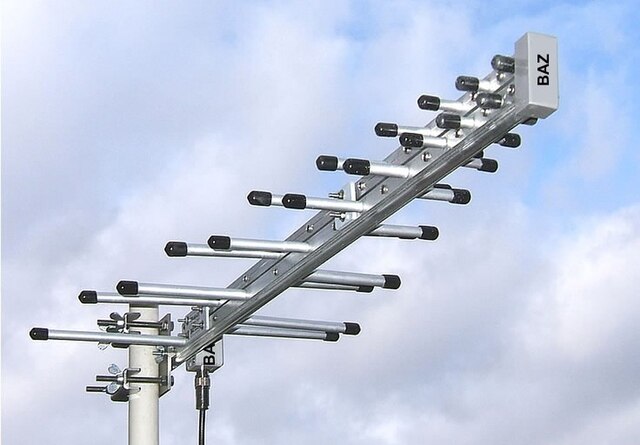Introduction to LPDA Antenna
The LPDA antenna, or log periodic antenna, is a specialized directional antenna designed for broadband frequency applications. Its structure consists of multiple dipole elements arranged in a specific pattern, allowing it to operate over a wide frequency range. Engineers and communication experts prefer this antenna for its versatility and efficiency in applications such as television broadcasting, wireless communications, and electromagnetic interference (EMI) testing.
The log periodic antenna features a distinctive design where the elements decrease in size as they move toward the front. This structure enables the antenna to provide consistent performance across multiple frequencies, making it ideal for various professional and commercial uses.
Working Principle of Log Periodic Antenna
An LPDA antenna works on the principle of periodicity and frequency scalability. It consists of several dipole elements of different lengths, positioned along a central boom. These elements are arranged in a logarithmic progression, ensuring that each section of the antenna resonates at a specific frequency range.
Key components of an LPDA antenna include:
- Boom: The main support structure holding the dipole elements.
- Dipole Elements: Varying-length conductors responsible for capturing signals.
- Feed System: A balanced transmission line connecting the elements to ensure efficient signal reception and transmission.
Unlike Yagi antennas, which are optimized for a single frequency, log periodic antennas cover broad frequency ranges while maintaining stable gain and impedance characteristics.
Applications of LPDA Antenna
The LPDA antenna is used in various industries due to its broad frequency range and high gain. Some common applications include:
1. Television and Radio Broadcasting
Broadcasting stations require antennas that can handle multiple frequencies. The log periodic antenna ensures clear transmission and reception, making it a preferred choice for television and FM radio broadcasting.
2. Wireless Communication Systems
Cellular networks and Wi-Fi providers utilize LPDA antennas for signal distribution. These antennas offer reliable performance in dynamic environments, ensuring strong connectivity.
3. EMI and EMC Testing
Electromagnetic interference (EMI) and electromagnetic compatibility (EMC) testing require antennas capable of handling broad frequency spectrums. LPDA antennas are widely used in laboratories to evaluate device compliance with regulatory standards.
4. Military and Defense Applications
In military communications, LPDA antennas provide secure and stable connections across multiple frequency bands. Their directional capabilities make them ideal for surveillance, reconnaissance, and jamming applications.
Advantages and LPDA Antenna Price Factors
Log periodic antennas offer several advantages over other types of directional antennas. Some key benefits include:
- Broadband Coverage: Operates over a wide frequency range, making it suitable for multiple applications.
- Stable Gain: Maintains consistent gain across different frequencies.
- Durability: Designed to withstand harsh weather conditions for outdoor use.
- Compact Design: Lightweight and easy to install.
The LPDA antenna price varies based on factors such as frequency range, gain, material quality, and brand. Entry-level models for personal use may cost around $50 to $150, while professional-grade versions with enhanced performance can exceed $500. Custom-built antennas for specialized applications may have even higher price tags depending on specifications.
Installation and Maintenance of Log Periodic Antenna
Proper installation and maintenance are crucial for ensuring optimal performance of an LPDA antenna. Consider the following best practices:
Installation Guidelines
- Positioning: Install the antenna at an elevated location for maximum signal reception.
- Alignment: Point the antenna towards the desired transmission source to enhance efficiency.
- Secure Mounting: Use sturdy poles or brackets to prevent movement during strong winds.
- Cable Connections: Ensure proper shielding and grounding of cables to minimize signal loss.
- Testing: Perform signal tests after installation to verify performance and adjust positioning if needed.
Maintenance Tips
- Regular Inspection: Check for loose connections and damaged elements.
- Cleaning: Remove dirt, dust, and corrosion buildup to maintain efficiency.
- Weatherproofing: Apply protective coatings or covers for outdoor installations.
- Upgrades: Consider replacing outdated components to improve performance over time.
Conclusion
LPDA antennas provide a versatile and reliable solution for various communication needs. Their ability to cover a broad frequency range makes them indispensable in broadcasting, wireless communications, and military applications. With stable gain, durability, and compact design, log periodic antennas continue to be a preferred choice in professional and industrial settings. Evaluating factors like specifications, brand, and LPDA antenna price helps users choose the right model for their requirements. Proper installation and maintenance further ensure long-term efficiency and optimal performance.









